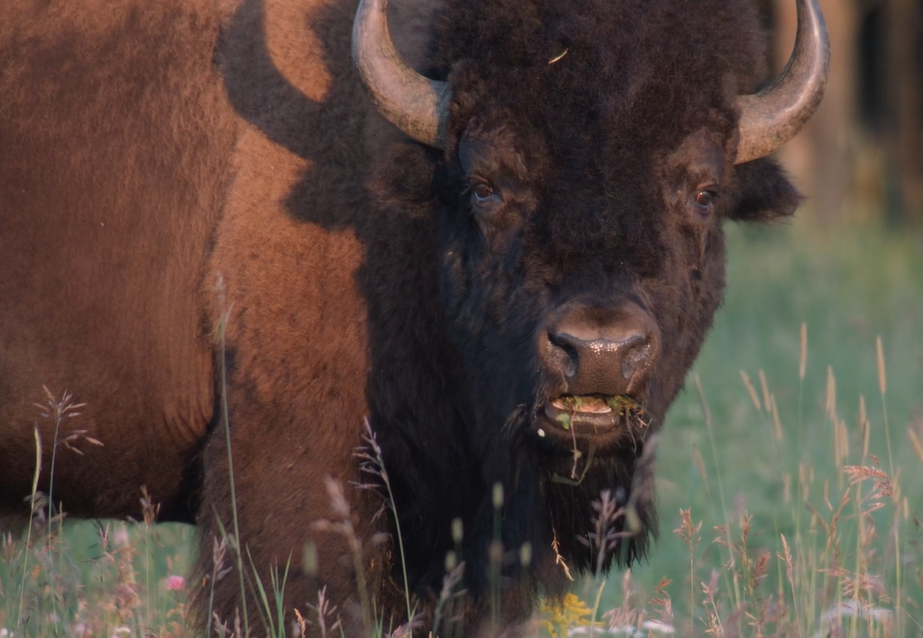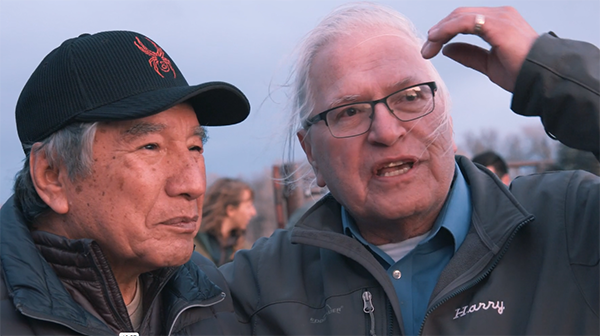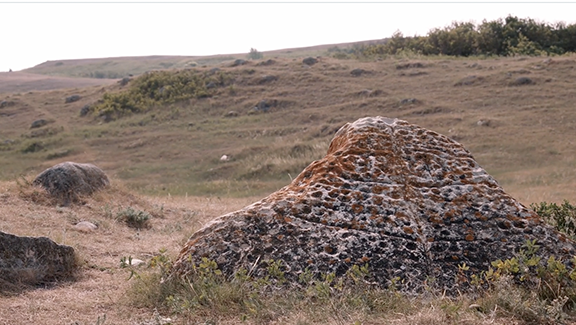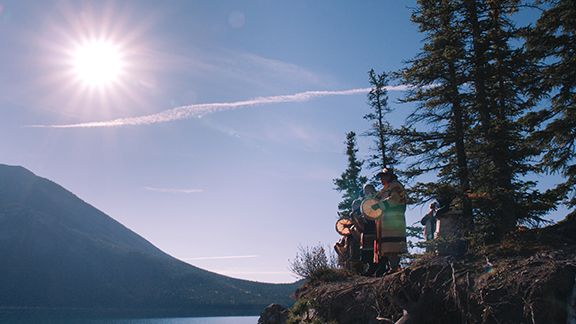
UPDATE:
Singing Back the Buffalo the new feature length documentary from award-winning Cree filmmaker Tasha Hubbard (nîpawistamâsowin: We Will Stand Up, Birth of a Family) will have its Canadian premiere at the 2024 Hot Docs Film Festival in the Land|Sky|Sea programme.
Hot Docs Screenings:
April 26, 2024 5:30 PM Tiff Lightbox 1
April 29, 2024 12:00 PM Tiff Lightbox 3
Original Buffalo Spirit Story
By Odette Auger, Windspeaker’s Buffalo Spirit Reporter
Award-winning documentarian and Buffalo advocate Tasha Hubbard will premiere her feature-length film Singing Back the Buffalo at the 2024 Big Sky Documentary Film Festival in Missoula, Montana.
The film follows the work of the people, organizations and communities working together to renew and restore Buffalo to the territories where they once roamed free.
Hubbard’s documentary looks at the Buffalo Treaty, first signed between eight First Nations in 2014, and how it is expanding and changing the Buffalo landscape. The film folds in Elder stories and prophecies to demonstrate how Buffalo people, human people and the health of the land are intrinsically linked.
She explains the parallels between the impacts of the colonial genocide on the Buffalo relatives, the slaughter of which led to their near extinction, and the lost independence of Indigenous Nations, stripped of their movement and agency through government policy and legislation.
“Cree Elders spoke of how Indigenous people, confined to our reserves, resemble the state of the Buffalo. Both of us behind fences and unable to move across our lands. We are slowly tearing these fences down through resistance and undoing the impacts of colonization,” Hubbard says in the film.
“While the depletion of the Buffalo has been understood as a contributing factor in the subjugation of plains Indigenous people, what has had less attention is the attack on the integral relationship between the Buffalo and Indigenous people,” Hubbard says.

The wise ones remember, says Hubbard in Singing Back the Buffalo, that First Nations people stopped singing when the Buffalo were gone.
Hubbard is a writer, filmmaker and associate professor at the University of Alberta and did her Ph.D on Buffalo consciousness.
Many will remember her film nîpawistamâsowin: We Will Stand Up about the shooting death of Colten Boushie, and the family’s effort to seek justice after the acquittal of the farmer who fatally shot the young man. Another of her films, Birth of a Family, documents four siblings separated in the Sixties Scoop.
Hubbard is from Peepeekisis First Nation in Treaty 4 in the Qu’Appelle Valley in southern Saskatchewan. Her mother is Donna Pinay. Her father Albert Angus is from Thunderchild and her family is historically from Stoney Knoll First Nation, both in Treaty 6 territory.
She describes her homelands lovingly.
“I am from lands that were once vast seas of grass. There are still islands of that, and I was lucky to grow up near one of those islands,” she said. “So I heard the birds, the insects, the way the wind sounds when it goes through the grass. That’s home for me.”
She explains though that she was disconnected from her Cree people as a child, “raised away by a farming family.” She only reconnected with her biological family in her late teens, and that reconnection brought her to her Buffalo advocacy.
In her film Singing Back the Buffalo Hubbard shares how she imaged the Qu’Appelle Valley teeming with Buffalo and describes what First Nations have learned and adopted from them.
Buffalo are matriarchal, with the strongest cows as leaders, who raise their oldest daughters to lead next. Cows and bulls work together to protect the youngest and oldest of the group.
At one point in the film, a man who is working to restore Buffalo in the United States, explains how the Assiniboine four-day mourning ritual was influenced by Buffalo behaviour.
For Hubbard, these teachings have brought her closer to her roots.
She has spent years working to support the Buffalo, knowing she would create a film one day around that work and the people she was meeting along the way.
“I had been an active supporter of the Buffalo Treaty since 2015, and I am co-founder of a non-profit called the International Buffalo Relations Institute, and we have some projects in progress. We decided to include that as part of the film.”
Singing Back the Buffalo begins with Hubbard walking through the wind-spirited grasses.
She hadn’t planned on being in front of the camera.
As she moved from proposal to working with producers Bonnie Thompson and Jason Ryle, it became clear her voice would be an important element in the film.
She told them about her imaginings as a child, in her mind’s eye seeing the herds run through the Qu’Appelle Valley, “and that was the times I felt Cree. I felt like who I was supposed to be at a time when I didn’t have access to any of that,” she said.
It was an emotional moment for all, and her reluctance to be in the film fell away.
The film opens with her telling the story of being taken to visit a Buffalo ribstone 20 years ago. These are rocks carved with groves and pits to look like a Buffalo rib cage.

“These ribstones reconnect us to our kinship with our families and to Buffalo,” Hubbard explains as the camera’s gaze gently details the texture and colours of the stone. “We sang to it, and, for a moment, we thought it sang back.”
The film also tells the story of the Buffalo Child Stone and how a boy raised by Buffalo was transformed to a stone where Indigenous people could gather and pray and sing together to honor the Buffalo’s sacrifice. And it tells how government blew up that stone to make room for a dam. Hubbard’s family were among the last to hold ceremony at the stone before it was destroyed.
After that first visit to a ribstone, Hubbard said “I couldn’t get Buffalo out of my mind and so I knew I was going to make a film one day. And I would tell people that. But it took a lot longer than I thought.”
Hubbard grew up spending a lot of time outside in the grasslands behind her house.
“I also had time as a kid to be bored and therefore rely on my imagination. And my grandfather Art Taylor taught me how to observe, how to listen.”
Reconnecting with her Cree family is part of the journey she shares in the film, and she explains that when she met them she “saw that my family are artists and musicians, but I can’t draw or sing,” she said, so Hubbard “decided to figure out what my talent might be.”
In 1997, while attending Dreamspeakers Film Festival in Edmonton, she met an “amazing Indigenous filmmaker, Gil Cardinal, who told me that storytelling was in my blood and I should pursue it,” Hubbard said.
“He also knew what it was like to be in the process of reconnecting, and he said filmmaking was a wonderful way to learn every day. And I still think about that when I make my films,” said Hubbard. “I love the learning part of it.”

Singing Back the Buffalo
The name of the film is not just a poetic device. Through the film we learn of the people using their voices to carry songs to the Buffalo relations, singing them back home as they arrive to repopulate territories.
Says Dr. Leroy Little Bear, a scholar from the Blood Tribe, and driver of the Buffalo Treaty, “We still have the songs. We tell the stories. We have the ceremonies. But there’s no Buffalo to be seen.” He then describes what’s beneath the work being done. “We need to bring that Buffalo back so that our youth will make that connection so that when they share the songs, they’ll know what they’re singing about.”
While we learn about the network of collaboration between intertribal Buffalo councils, independent buffalo ranchers, the mentorship pairing, the work towards rematriating Buffalo, we also hear some of the songs and the drumming welcoming the Buffalo relatives home.
Protocols were carefully adhered to around certain songs, said Hubbard.
“Some songs are not meant to be recorded, and coming to understand over the years why that is, I respect that fully,” Hubbard said. “Some things are not meant for the camera, and that’s ok. Contemporary audiences are taught to expect to always have access, and that isn’t how it works within Indigenous communities.”
“Some things you earn, some things are only meant for that moment, and that’s ok. So with the different singers in the film, it was a conversation as to what could be recorded. People would sing a song and would tell me, ‘This one is ok. This one you can use’.”
Hubbard takes her role as artist as something that comes from a spiritual place, and she explains that artists “should be held in high esteem and influence.”
“I learned very early in my career that there is a connection between my creative process and my spiritual self and that of my family.”
Hubbard’s awareness of the relations that came before her and those yet to come “requires me to be open and to listen when I’m told something,” she said.
“My process of making this film involved ceremony and going to visit sacred sites. It included visiting the Buffalo. Through my learning process, which is still in progress, I try to understand the Buffalo’s role and our role and how to understand them as more than human people we share the land with. What we are taught by mainstream society cuts that out, to our detriment.”
Singing Back the Buffalo communicates the traumas and deep loss of the past and the soaring hope of the future.
“My hope is that viewers fall deeply in love with the Buffalo,” said Hubbard. “I hope people think of our relationships with the more than human and what thinking of them as our relatives does to how we engage with the environments we live in. I also hope they think about the power of Indigenous storytelling and are inspired to watch more Indigenous-made films.”
Big Sky Documentary Film Festival runs from Feb. 15 to Feb. 25. Singing Back the Buffalo screens on Feb. 24. It is not available for virtual streaming. Watch for the documentary on the film festival circuit throughout 2024. View the trailer here.
